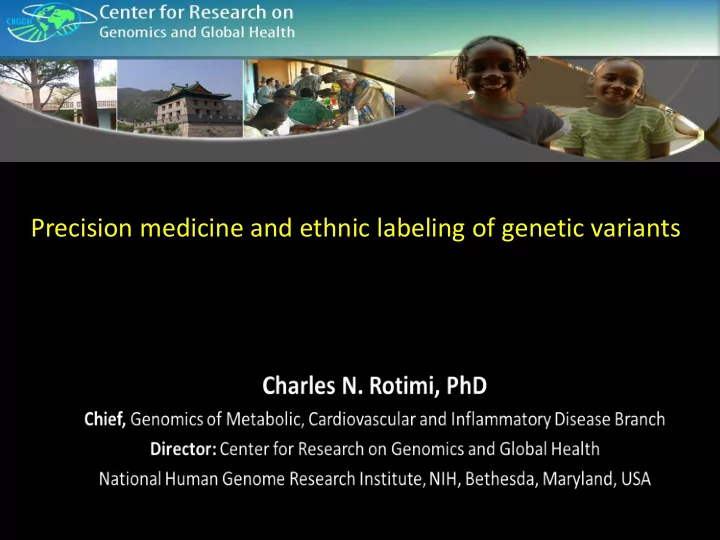

Precision medicine and ethnic labeling of genetic variants
1. Investigated ancestry of 3,528 modern humans (163 ethno-linguistic groups) 2. 19 ancestral components 3. 94.4% of individuals showed mixed ancestry 4. Refined understanding of the ancestry of several ethno-linguistic groups, including African Americans, Ethiopians, the Kalash, Latin Americans, Mozabites, Pygmies, and Uygurs, as well as the CEU sample. 5. Ubiquity of mixed ancestry emphasizes the importance of accounting for ancestry in history, forensics, and health.
Self identified African Americans includes individuals with as low as 0.6% to as high as 99.7% African ancestry – Average is ~80%
Individual ancestry is more informative than ethnicity HISPANIC Native African Native American African American European European Mexican Puerto Rican Puerto Rican 100% 80% 60% 40% 20% 0% 10 13 16 19 22 25 28 31 34 37 40 43 46 49 52 55 58 61 64 67 70 73 76 79 82 85 88 1 4 7
Genetic ancestry and risk of relapse . N=2,534 Five-year survival rates for Childhood acute lymphoblastic leukemia (ALL) is over 80% in industrialized countries. Not all children have benefited equally from the progress. Ethnic difference in survival is well known. Euro=red; African=gray; Asian=green; NA=blue Using whole genome approach, it was shown that the component of genomic variation that co-segregate with Native American ancestry was associated with risk of relapse (p=0.0029). Importantly, ancestry-related risk of relapse was mitigated by the addition of single extra phase of chemotherapy. Charles Rotimi - rotimic@mail.nih.gov
NEJM July 2010
1. Hepatitis C virus infection affects 170 million people worldwide; the leading cause of cirrhosis in North America. 2. Treatment - 48-week course of peginterferon- alpha-2b or -alpha-2a combined with ribavirin (RBV). 3. Many patients will not be cured by treatment; Patients of European ancestry have higher probability of being cured than patients of African ancestry. 4. Finding - SNP rs12979860 near the IL28B gene, encoding interferon-lambda-3, is associated with ~2-fold change in response to treatment in patients of European ancestry and African- SVR – sustained virological Americans. response Nature. Sep 17; 2009 . Charles Rotimi - crggh.nih.gov
Population # of individuals Mean Frequency Frequency Range Groups (# of populations) Africa 428 (10) 36.2 23.1 – 54.8 Europe 761 (13) 68.35 52.8 – 85.7 East Asia 380 (8) 94.93 90.0 – 100.0 Because the genotype leading to better response is in substantially greater frequency in European than African populations, this genetic polymorphism also explains approximately half of the difference in response rates between African-Americans and patients of European ancestry Nature. Sep 17; 2009 . Nature – Oct 8, 2009 Charles Rotimi - crggh.nih.gov
A GRK5 polymorphism that inhibits β -adrenergic receptor signaling is protective in heart failure 1. G protein-coupled receptor kinases (GRKs) desensitize β -adrenergic receptors ( β ARs). 2. Re-sequencing of GRK5 revealed a nonsynonymous polymorphism - leucine is substituted for glutamine at position 41; GRK5-Leu41 allele is common in AA (~40%). 3. Results offer an explanation for the confusion in the findings of clinical trials of β - blocker. β -blockers are absolutely effective in AA without the variant. GRK5-Q41 only - with and GRK5-Q41 only txt with β - GRK5-L41 only - with and without b-blocker use blocker vs GRK5-L41 only without b-blocker use Liggett SB et al. Nat. Medicine April 2008 Charles Rotimi - crggh.nih.gov
APOL1 and Kidney Disease OR=10.5 for ESRD for carriers of two copies of the APOL1 risk allele Freq of APOL1 risk variant SNP rs73885319 varies worldwide: Yoruba - 0.4 African American - 0.2 Absent in Europeans and Asians APOL 1 is a serum factor that lyses trypanosomes. In vitro assays revealed that only the kidney disease-associated ApoL1 variants lysed Trypanosoma brucei rhodesiense. Kidney disease risk variants likely rose to high freq in Africa because they confer resistance to trypanosomal infection and protect against the lethal form of African sleeping sickness
• 136 African American donor kidneys • 22 with APOL1 risk alleles • Graft survival shorter in donor kidneys with 2 APOL1 risk variants • (HR 3.8, p=0.008) • No difference by overall African ancestry Graft survival rates from African Americans without the APOL1 risk alleles were not different than those from non-African American donors.
Healthier lipid profile is observed in African ancestry populations - Why?
Lipid-Influencing Variants with Ethnicity-Specific Effects in African Americans Findings 1. SNP rs328 ( LPL ) associated with higher HDLC and lower TG. Stronger effect was observed on a “European” vs. “African” genetic background. 2. To investigate this ancestry effect, we evaluated the region among West Africans Bentley A et al. PLOS Genetics 2014
Individuals cannot be treated as representative for all those who physically resemble them, or have some of the same ancestry.
The Danger of Group Labelling of Human Genetic Variation Genetic Screening to Prevent Abacavir Hypersensitivity (AHS) Reaction • HLA-B*5701 - negative predictive value of 100% for patch-test-confirmed AHS for both Whites and Blacks • Africa - 13.6% (Maasai), 0% (Yoruba). • African Americans – 1% • Europe – 3.4% (Tuscans), 5.8% (Utah). • Use of the label “Black” distorts radically different frequency distribution that may lead to wrong public health decision about who to screen. Variation in the HLA-B*5701 Locus in 11 HapMap Samples Rotimi CN, Jorde LB. Ancestry and Disease in the Age of Genomic Medicine . (2010)
Precision Medicine Race and ethnicity are imprecise indicators of who will or will not respond to a drug or have a particular trait/disease Group definition should be based on individual genotype.
Regions Affected the most by Sickle Cell Disease Africa and South Asia have some of the highest rates of sickle cell in the world.
http://crggh.nih.gov Thanks Glad to take Questions Charles Rotimi - crggh.nih.gov
Recommend
More recommend